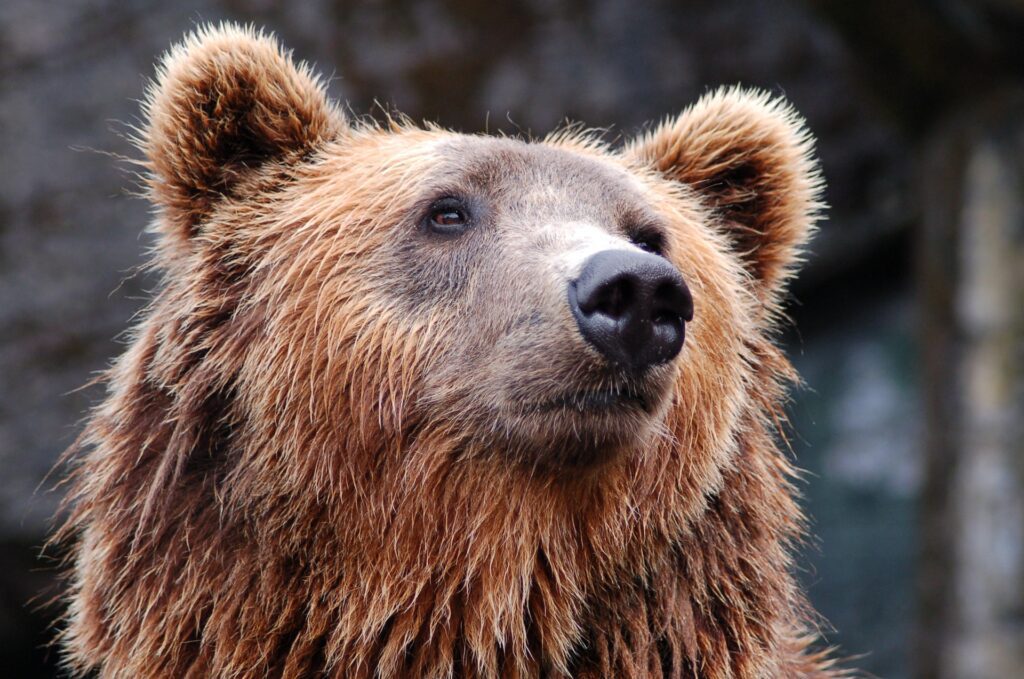Although at first glance it might seem strange, the question makes sense. Dogs and bears resemble each other somewhat. Are they more closely related than the average person realizes? Fortunately, science has some excellent explanations for the origins and classification of many animal species inhabiting the planet. Don’t you think a bear resembles a big, thick dog? Well, let’s confirm it for sure: Do bears and dogs have any kinship? Let’s examine bears and dogs.
Table of Contents
You may be interested: Can dogs eat cucumbers? Are cucumber seeds safe for dogs?

Are bears related to dogs?
The evolution of dogs and bears is the main topic of discussion here. If something is “related,” it means that two different animal species are closely related genetically.
Bears are not directly related to dogs, to put it briefly. They do, however, share a prehistoric ancestor with both species. Second, and perhaps more importantly, every living thing is connected. Both jellyfish and fungi are genetic relatives of humans, but their ancestry is considerably more remote than that of chimpanzees. How closely and distantly (temporally) species are related is the real question, and it is probably the one that is more helpful.
You’ll soon find out that between 62 and 32 million years ago, dogs and bears shared a common ancestor. Although both animals are mammals, they have since diverged from their common ancestor. Let’s delve deeper into the specifics of this connection!
How do we determine if two things are related?
The evolutionary background is the key factor in all inquiries into whether a species is “related” to another species. The question being asked is basically “How far back do these two species share a common ancestor?” Through various techniques, the evolutionary study enables us to look back in time and piece together puzzles, providing us with a clearer picture of the genetic heritage that all living things share. All living things can be traced back to a common ancestor.
Humans have investigated the relationships between various species in some ways. The most well-known (in the eyes of the general public) is probably fossil evidence. We frequently find bones or impressions of fossils that are unmistakably from a quasi-species that two current (existing) species likely descended from. A common ancestor is the two species’ most recent evolutionary link.
Through DNA, we can examine shared evolutionary history in a second and more significant way. We can see how things are related and look back in time with some degree of certainty thanks to DNA evidence. It is likely that the two species are closely related and had a recent common ancestor if their DNA is remarkably similar.
Why do bears look like dogs?
Well, the Caniformia were grouped with bears. Because of this, dogs and bears have a lot in common. Long snouts and non-retracting claws are two traits that the Caniformia subgroup developed and which are still present today. Not only bears were a byproduct of this assemblage.
Taxonomic classification: what is it?
Although somewhat tedious, it’s crucial to comprehend how scientists categorize organisms. We cannot determine if something is related without understanding classifications! Here is a fundamental explanation of classification. It’s crucial to comprehend the grouping system that humans use to organize information to make sense of the world if we want to comprehend “relatedness” on an evolutionary scale. The science of naming organisms and classifying them into related groups is known as taxonomy.
Consider taxonomy as a pyramid, with the top definitions being the most inclusive and the bottom definitions being the narrowest and most specific. For instance, plants, fungi, animals, and more are included in the six kingdoms, which is the second most inclusive category. Polar bears, grizzly bears, and black bears are among the closely related animals that fall under the most specific classification, species.

How closely are bears related to dogs?
How closely related are dogs and bears, then, to the immediate question at hand? Although they are not directly related, as we already established, taxonomic classifications can indicate how closely related two organisms are. You may have now read in other sources that they are not connected. However, the truth is that the two species are quite related! Bears and dogs both belong to the suborder Caniformia, which means “dog-like carnivorans” in Latin. Dogs, bears, wolves, foxes, raccoons, and mustelids are all included in this taxonomical group. This order contains numerous species, which can be identified by their non-retractable claws and omnivorous diets.
This suborder diverged from Feliformia, a group of carnivorans that included lions, cats, and other felines. There are currently nine families in the suborder Caniformia. The Canidae family includes dogs, wolves, and bears; the Ursidae family includes ursids.
Bears and dogs are therefore closely related if you compare them based on their respective sub-orders. Since they come from different families but are members of the same sub-order, they are, however, somewhat related in terms of their families. Finally, they are distantly related species-wise. In summary, although their families and species are different, dogs and bears are related by sub-order. In general, dogs, wolves, and bears are related by sub-order and share a recent common ancestor.
How Different Are Bears from Dogs?
There may be physical similarities between bears and dogs, but this does not necessarily imply that they are related. Bears walk on all fours as dogs do, and they may have facial features that resemble dogs. Dogs and bears both have snout structures that end in points, making them similar in appearance. Additionally, they both have claws, teeth, and fluffy coats. There are no further similarities, though.
Bears and dogs are members of two completely distinct animal species and have evolved from two different biological families, as they are not genetically related.
The Canidae family includes dogs and other canines, whereas the Ursidae family includes bears. Canidae are known for their carnivorous eating habits, urge to hunt in packs, and social group living. A group of large, powerful plantigrade carnivores known as the Ursidae family. This includes bear species like polar bears, pandas, and other bear species.
Dogs and bears cannot even interbreed because of how different they are from one another. Two different animal species must have some sort of shared ancestor that ties them together to successfully breed. Due to this, while many different dog species can interbreed and produce offspring, this is not the case for bears and dogs.
What common ancestor do bears and dogs share most recently?
After learning some of the fundamentals of evolutionary relatedness, let’s examine the most recent ancestor that bears and dogs have in common. Bears, wolves, and dogs all descended from this ancestor, along with a few other families. Miacids are the most recent common ancestor of bears and dogs. Miacids, which existed 62–32 million years ago, are extinct now. They did fairly well, living for at least 28 million years. It is thought that these extinct mammals served as the foundation for the order Carnivora, from which the suborders Caniformia and Feliformia diverged. With some living in the trees and others on the ground, they resembled martens and weasels.
All modern carnivores descended from miacids, which probably preyed on anything smaller than themselves. These Miacids specialized in their ecological niches as they multiplied. The abundance of meat and herd animals in Africa, where felines first appeared, probably helped them to develop into the superpredators that we now know as lions and leopards. More omnivorous animals, like bears, dogs, and otters, were developed in North America and Europe as a result of the need for a more varied diet.
Final Thoughts:
The conclusion of the question ” Are bears related to dogs “, despite their many similarities, bears and dogs are not related, and have not been for millions of years. There is no actual relationship between the various species, even though your chocolate lab might resemble a tiny brown bear or your Samoyed might resemble a tiny polar bear. Which, if you value your safety, is probably a good thing!
References: animal pickings, wikidoggia, a-z-animals
Relate posts